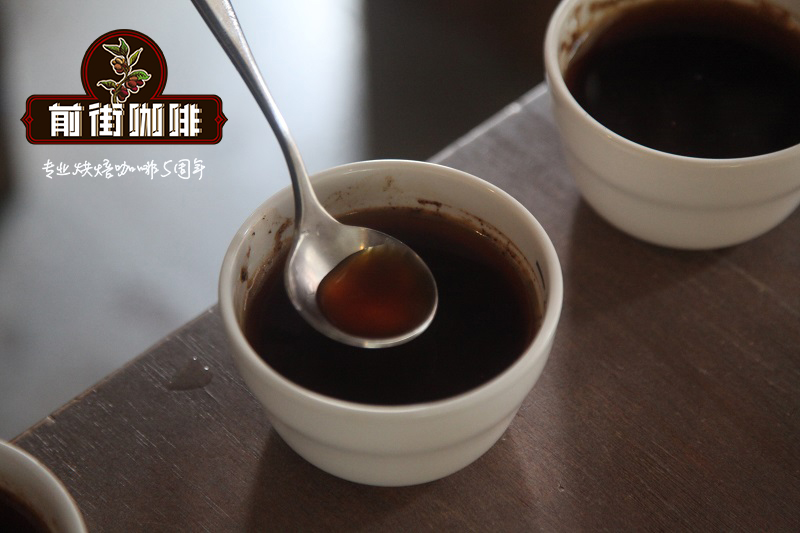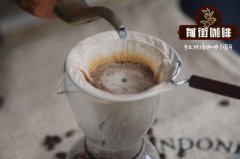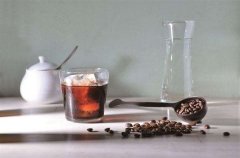What are the phenomena and causes of the cooking process? What kind of steaming? How do you cook it?

Professional coffee knowledge exchange more coffee bean information please follow the coffee workshop (Wechat official account cafe_style)
What are the phenomena and causes of the cooking process? What kind of steaming? How do you cook it?
1. The phenomenon of steaming: expanding into a hill.
When hot water is poured in, the gas in the coffee powder expands due to heating (when the coffee powder is enlarged, it will look like a honeycomb, with many gaps). After the gas expansion, it will begin to discharge the excess gas, which will cause the coffee powder and hot water to form an expanding hill on the outside (Note 1). At the same time, in addition to the discharge of gas from the inside of the coffee powder, hot water also slowly seeps into the inside of the coffee powder so that some soluble substances in the coffee powder begin to dissolve and form a high concentration of coffee liquid.
In the final stage of steaming, because the gas is almost discharged, the whole temperature decreases, and some undischarged air begins to shrink slightly, so from the outside, the hill will also become moist and slowly show a phenomenon of drying or slightly cracking and collapsing (figure 3), which also represents the completion of steaming and can begin a second water injection.
When injecting water for the second time, the high concentration of coffee liquid dissolved first during steaming will move to low concentration hot water. In the whole brewing process, due to the continuous pouring of hot water and the constant dripping of coffee, the concentration of coffee powder inside and outside will be different. This is also the reason why the coffee will be stronger at the beginning and lighter in the second half.
The factors affecting steaming include the level of water temperature, the amount of water, the length of steaming time and the storage time of coffee beans (figure 4).
Note 1: in two cases, the expansion rate during steaming is not obvious or even unresponsive, which are freshness and baking degree respectively. First of all, there is a certain amount of gas in the fresh coffee powder, the gas in the coffee powder will be discharged slowly over time, and the coffee powder absorbs some moisture in the air, resulting in less gas, so stale ripe beans are less likely to expand or even have no reaction. Second, shallow roasted beans are less likely to expand too violently, because lightly roasted coffee beans are denser, so the overall void is not as large as medium or deep roasting, so it contains less gas.'
At the beginning of steaming, there is a surface tension formed by hot water and coffee powder expansion.
And the appearance is relatively moist.
After steaming for a few seconds, the appearance begins to dry and stops expanding.
The steaming is almost over, and small grooves begin to appear on the surface.
These are beans that have been kept for five or six months, and there is no expansion at all.
2. The difference of steaming or not: without steaming, the extraction is easy to be insufficient.
Steamed coffee powder, coffee powder will first dissolve some high concentration coffee liquid because it seeps into some hot water, so it is easier to extract some soluble substances of coffee during the second water injection, and some gases in the coffee powder have been discharged at the same time of steaming, so it is less likely to be disturbed by gas discharge during brewing extraction in order to achieve stable and uniform extraction.
If there is no steaming, it is easier to extract only the ingredients on the surface of the coffee powder, while the internal substances are not easy to be extracted, and because some gases in the coffee powder have not been discharged at the beginning, the time to float on the surface will be longer than that of steaming, resulting in insufficient extraction and lighter concentration of coffee.
3. After steaming, the difference of water injection in different times:
The concentration of water injection is high, and the concentration is low without water injection.
Undivided water injection: after steaming, continuous water injection until the required amount is stopped.
Step-by-step water injection: after the end of steaming, water injection will be divided into several times. after each stop, before the water level reaches the coffee powder noodle, hot water will be injected until the required amount is reached. (note 2)
As to why there is a difference in concentration between the two? First of all, let's briefly explain the way the liquid spreads, that is, the liquid with higher concentration will move to the liquid with lower concentration, and dissolving the high concentration coffee into the water is of course a kind of diffusion effect, so it is said before that the second injection after steaming, the high concentration coffee liquid dissolved first will move to the low concentration hot water.
Therefore, if we take step-by-step water injection, we will bring some high-concentration coffee liquid into the low-concentration hot water that has just been injected, so it will cause continuous extraction of high-concentration coffee liquid, but it is also relatively easy to extract the astringent odor. And in the process of water injection, the force of the water flow will disturb the coffee powder deposited at the bottom, so pay more attention to the water injection. Avoid extractive and astringent flavors. On the contrary, undivided water injection is adopted to retain some coffee liquid with higher concentration than hot water, so the concentration balance may even occur during extraction.
No matter which way, the extraction time is too long, it will bring out the bitter mixed taste (figure 2). This is because when the extraction is too long, almost all the good taste is extracted, and most of the bad taste is left behind. And the liquid concentration will continue to dissolve the bad taste in order to achieve balance. In fact, in the operation, which way to take can be decided according to the taste preference and the condition of beans.
Note 2: the first water injection after steaming will have an obvious water level, and the subsequent water injection should not exceed this height. The frequency of water injection is mainly based on the amount required.'
4. The height of the water column
The higher the height of the water column, the greater the impact of the water flow, and the difficulty of stable circling will also increase, resulting in greater disturbance in the extraction process, unable to evenly extract coffee powder, resulting in increased astringent taste; if the water column height is too low, the hand punch pot is easy to knock on the filter cup, but if you use low water injection, the speed of the circle is not too slow or pause, because it will make the coffee powder at the bottom tumble up.
On the left, the spout is about 5 cm away from the coffee surface; on the right, the spout is about 15 cm away from the coffee surface.
5. The speed of the circle
If it is too fast, it will cause great disturbance; if it is too slow, the extraction time will be too long, resulting in a bitter taste (figure 5). Take medium and light baked beans as an example, generally speaking, a little faster, the taste will be brighter; a little slower, the taste will be softer.
6. the size of the circle
The size of the coil will also affect the extraction rate. If you only circle the middle small circle (about 50 yuan), the amount of water injected into the whole cup will be a little less than what was said before, as for what proportion to modify depends on the actual situation, and the small circle will cause the surrounding coffee powder, there is no way to effectively and completely dissolve out, so if you maintain the powder-to-water ratio at 1:17, it will easily cause excessive extraction. If it is wound to the edge of the filter cup, it is easy for the water to flow directly into the coffee pot without passing through the coffee powder, resulting in insufficient extraction of the whole cup. Therefore, at the beginning of the practice, the water column can be kept at least 0.5 cm away from the filter cup.
Try to keep it in the red circle when circling
7. The level of water temperature
The temperature will affect the dissolution efficiency of the whole coffee, the higher the temperature is, the faster the dissolution rate is, and the more soluble substances are dissolved in the same extraction time, so generally speaking, the water temperature is too high to exceed 95 degrees, which is easy to make the bitter taste and astringent taste dissolve quickly. The lower the temperature, the slower the dissolution rate, and the less soluble substances are dissolved in the same extraction time, so generally speaking, the water temperature is too low, the coffee will be easy to thin, the good taste is not easy to extract, and steaming is not easy to complete.
8. Ratio of water to powder
Generally speaking, powder: water = about 1:17. Of course, this is just an idea, the proportion can also be used at 1:12. It is mainly hoped that the extraction can make effective use of coffee powder as far as possible, so that it is not wasted or overused, because coffee beans contain about 30% of the soluble substances (figure 6), of which 30% soluble substances also contain all the good and bad flavors, so insufficient extraction will cause flavor imbalance, excessive extraction will cause bitterness and miscellaneous taste, so there is also the argument of Gold Cup. It is hoped that the extraction rate is between 18% and 22%, and the concentration is 1.2% and 1.5%.
When there is a large amount of powder (more than three or four cups), the water column of water injection should not be too small, so that the extraction time will not be too long (figure 5).
Figure 6: extraction rate and coffee concentration (from the European Fine Coffee Association)
9. Coffee powder thickness
The thickness of coffee powder also affects the extraction rate. The finer the coffee powder is, the higher the extraction rate is, and the coarser the coffee powder is, the smaller the extraction rate is. Generally speaking, the thickness requirement of hand grinding is about medium grinding, which is about the size of the No. 2 sugar of Taiwan Sugar, because if the grinding is too fine, many fine powders will easily settle on the bottom of the filter cup, causing blockage, which slows down the whole flow rate and prolongs the time (figure 5). If the grinding is too coarse, the coffee powder is easy to be underextracted.
10. Whether the filter paper is wet first or not
Wet the filter paper first to make the coffee liquid penetrate faster at first, and wet it first can also achieve the effect of warming the pot. There are first wet can also flush out some, filter paper in the manufacturing process may be residual chemicals, because now on the market filter paper material and brand, the quality is also uneven, some add fluorescent agent, hydrogen peroxide (H2O2) bleaching treatment, even if there is no bleaching, there is a risk, because the manufacturing process requires more processes to remove the smell of lignin.
11. The difference of filter cup
There are many kinds of filter cups, different types of filter cups will cause coffee liquid dripping speed is different, but also affect the extraction time of the whole cup, and sometimes according to different filter cups, it is necessary to slightly adjust the cooking method. There are also filter cups of different materials, which will also affect the temperature of the extraction process, such as ceramic filter cups have better thermal insulation than spring filter cups in the extraction process.
Important Notice :
前街咖啡 FrontStreet Coffee has moved to new addredd:
FrontStreet Coffee Address: 315,Donghua East Road,GuangZhou
Tel:020 38364473
- Prev

Insufficient coffee extraction? Excessive extraction? How to know by tasting? How do you judge?
Professional coffee knowledge exchange more coffee bean information please pay attention to the coffee workshop (Wechat official account cafe_style) lack of coffee extraction? Excessive extraction? How to know by tasting? How do you judge? This article will be linked by the basic theory of coffee extraction and the tasting of coffee in three cases: over-extraction, under-extraction and ideal extraction. The extraction can be said to be in the brewing of coffee.
- Next

Cold coffee is low in caffeine. Experts say this...
Professional coffee knowledge exchange More coffee bean information Please pay attention to coffee workshop (Weixin Official Accounts cafe_style) The following table is the dissolution relationship between temperature and caffeine. Caffeine is a water-soluble substance, usually in the form of water without crystals or water of crystals. Pure caffeine is white powder or white needle-like crystals, odorless, bitter taste. by PIN NETWORK
Related
- Detailed explanation of Jadeite planting Land in Panamanian Jadeite Manor introduction to the grading system of Jadeite competitive bidding, Red bid, Green bid and Rose Summer
- Story of Coffee planting in Brenka region of Costa Rica Stonehenge Manor anaerobic heavy honey treatment of flavor mouth
- What's on the barrel of Blue Mountain Coffee beans?
- Can American coffee also pull flowers? How to use hot American style to pull out a good-looking pattern?
- Can you make a cold extract with coffee beans? What is the right proportion for cold-extracted coffee formula?
- Indonesian PWN Gold Mandrine Coffee Origin Features Flavor How to Chong? Mandolin coffee is American.
- A brief introduction to the flavor characteristics of Brazilian yellow bourbon coffee beans
- What is the effect of different water quality on the flavor of cold-extracted coffee? What kind of water is best for brewing coffee?
- Why do you think of Rose Summer whenever you mention Panamanian coffee?
- Introduction to the characteristics of authentic blue mountain coffee bean producing areas? What is the CIB Coffee Authority in Jamaica?

